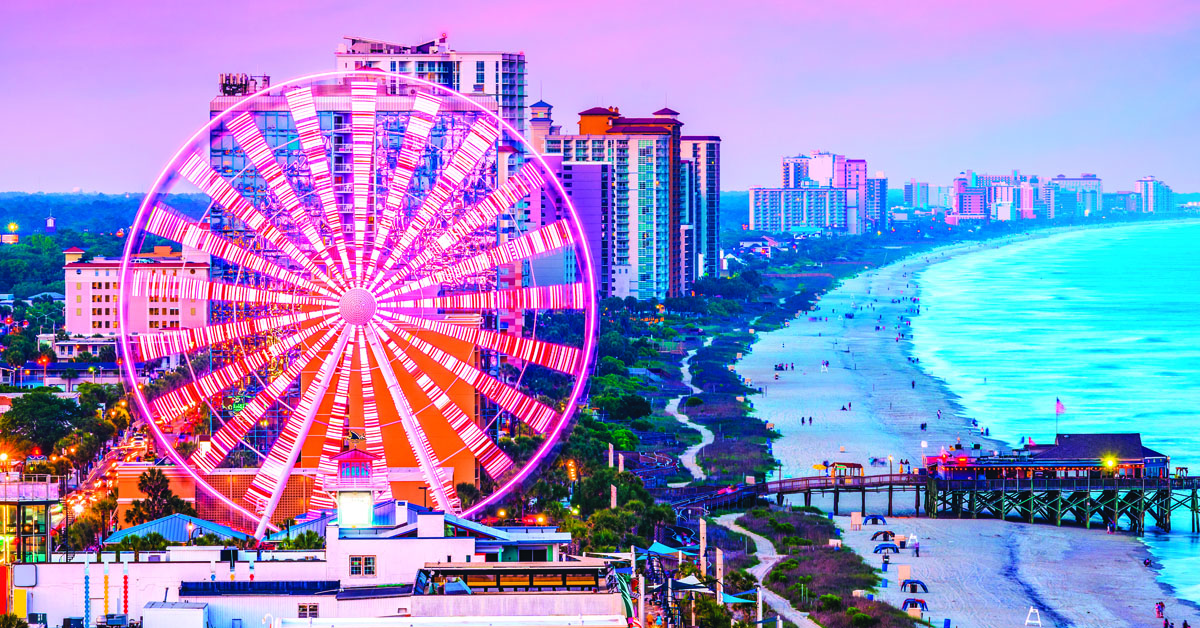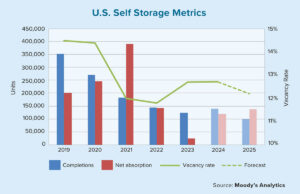Population growth in the Atlantic Region isn’t as explosive compared to portions of the western U.S., but these five eastern states are generally expanding more quickly than the country as a whole. For example, South Carolina’s population jumped by 9.5% from 2021 to 2022, good for No. 10 among all states.
North Carolina (8.5%), Virginia (7.2%) and Maryland (6.5%) each eclipsed the national average of 6.1% growth during the year. West Virginia was the lone outlier in the region as its population shrank by 3.3%. It joined Illinois and Mississippi as the only states to experience a net loss last year.
The Atlantic Region also encompasses Washington, D.C. After bottoming out at the turn of the century with a population of 572,000, the nation’s capital saw a significant boom over the next 20 years. Even after a slight decline since the onset of the COVID-19 pandemic, the District of Columbia still has 672,000 residents.
North Carolina has the region’s largest economy at $716 billion, ranking No. 11 among all states. The Tar Heel State is known for legacy industries such as textiles, tobacco and furniture making, but it’s also on the cutting edge of 21st century advances in aerospace, biotechnology and financial services.
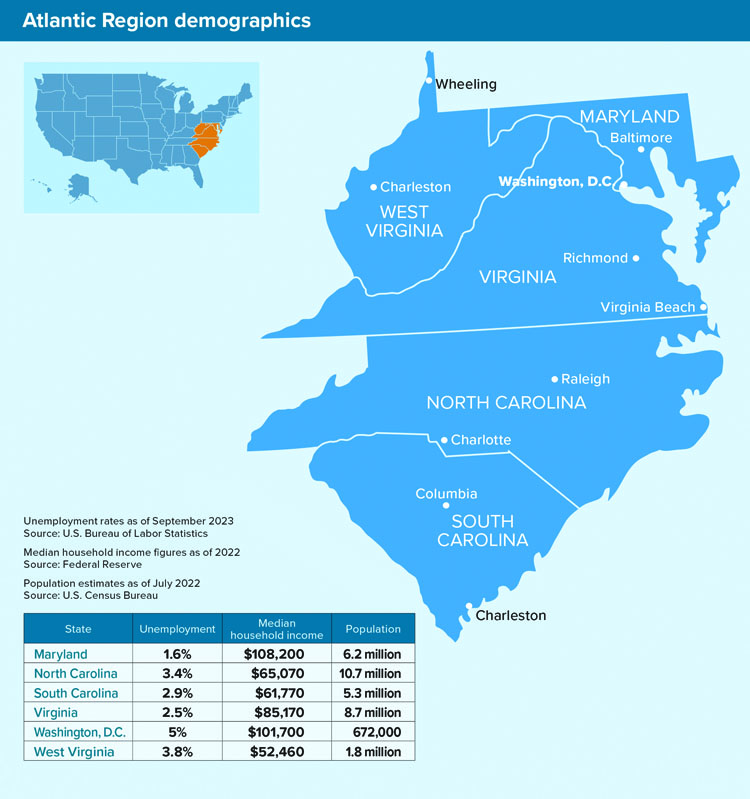
Virginia has the nation’s 13th-largest economy at $663 billion. The Old Dominion features a diverse array of business sectors from defense and data storage to food processing and logistics. A number of key projects are underway in Virginia, including a $9.8 billion wind farm off the Atlantic coast that’s set to power 650,000 homes and businesses; a multistory Amazon warehouse that will supply 1,000 jobs in Virginia Beach; and an $87 million infusion by Wells Fargo into its existing Roanoke customer service center.
With nearly 650 residents per square mile, Maryland ranks No. 5 among all states for highest population density and has a robust economy that is the nation’s 17th largest ($480 billion). The Old Line State has some 12,500 farms and a plethora of well-known food makers and distributors such as McCormick and Co., Perdue Farms, Pompeian Inc. and Domino Sugar.
In South Carolina, population centers like Columbia, Charleston and Greenville power an economy valued at $298 billion. Due in large part to its favorable tax incentives, the Palmetto State is becoming a hub for the burgeoning electric vehicle (EV) manufacturing industry. Within the past year, EV companies have struck four major deals totaling more than $6 billion to build plants across the state.
West Virginia’s $97 billion economy ranks in the bottom quartile of all states. The aforementioned population loss isn’t helping the Mountain State’s fiscal health, but there are bright spots. A five-year forecast released last year by West Virginia University economists called for slow but steady job growth through 2027. Several key developments are underway, including the expansion of a Toyota production plant, GreenPower Motor Co.’s new factory to build clean-energy school buses, and Berkshire Hathaway’s renewable- energy microgrid that will power a 2,000-acre industrial park. ●
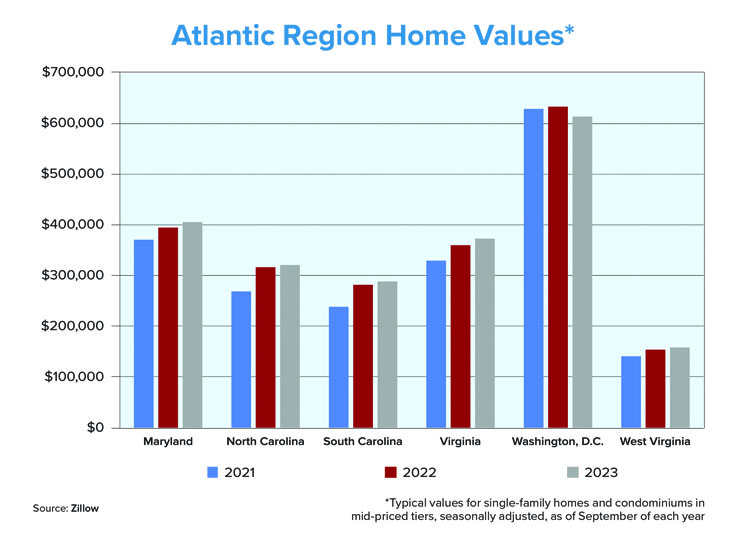
Zillow data shows steady and sustainable home price growth across the Atlantic Region over the past year. As of September 2023, annualized price growth was in the 2% to 3% range for most of these states, with Virginia leading the way at 4%.
The opposite trend occurred in Washington, D.C., where prices dropped 2.9% year over year. After peaking at $650,617 in June 2022, the typical home value in the nation’s capital stood at $614,146 this past September (a 5.6% decline).
According to real estate brokerage McEnearney Associates, the 5,200 sales in D.C. through the first nine months of this year were down 23% compared to the same period in 2022. Notably, however, sellers were more willing to offer concessions as the average subsidy reached $3,031, up from $2,026 during the first nine months of last year.
Personal finance website WalletHub recently ranked the North Carolina cities of Cary, Durham, Raleigh and Charlotte among the nation’s 30 best real estate markets. The analysis was based on metrics like affordability, price forecasts, the percentage of homes built since 2010, and the shares of mortgages that are delinquent or seriously underwater.
What the Locals Say
I would say that South Carolina is affordable. It’s expensive no matter where you are with inflation and things like that, but real estate taxes here are significantly less for residents. For nonresidents, it’s a different tax rate. It’s about encouraging people to make this your primary place of residence, not just using it as a vacation destination. South Carolina is also one of the most flexible states if you have a service-connected disability. If you’re a veteran with a 100% disability rating, you pay zero real estate taxes.
With mortgage rates nearing 8%, you could get sucked up into negativity quickly, like quicksand, and never get out of it. My team, we just don’t get too caught up in a lot of the noise and the negativity. We understand it. We’re watching it to be knowledgeable of the market, but we’re not feeding into it. There’s a difference. We’re not letting that control our day and our next move. I think there’s a lot of lenders that need to hear that message: Just focus on what matters and reconnect with the client for what they need.
The overall prices to build homes and get the finished product have gone up, but we’re seeing more homes that are catered to support the starter family. We’re seeing a lot of mid- to upper-level new homes but not what we would consider luxury-class or very high-end homes. These are homes for families. These are everyday, hardworking families that need a home. It’s important enough for the family to make that a priority over something else that might not be as important.

Branch manager
Nation One Mortgage Corp.
3 Cities to Watch
Charlotte

The Queen City added more than 15,000 new residents during the year ending in June 2022, census figures show, good for the fifth- largest numerical increase among U.S. cities. This growth also made Charlotte the 15th- largest city in the country with a population of nearly 900,000. With a presence in the NFL, NBA, Major League Soccer, NASCAR and the PGA Tour, Charlotte rates as the third-best city for sports business behind only Dallas and New York, according to the Sports Business Journal.
Virginia Beach
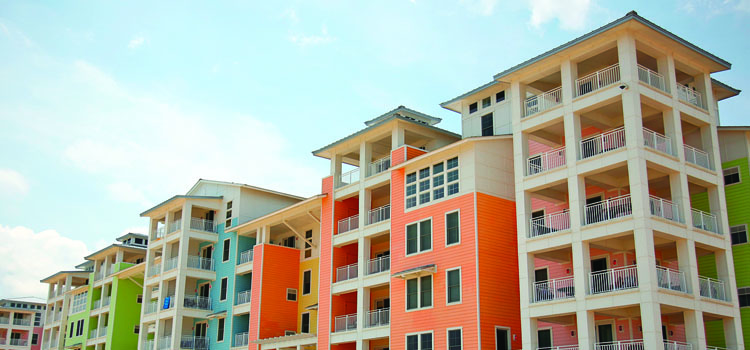
Virginia’s largest city (455,000 residents) anchors the Hampton Roads metro area and its population of 1.8 million. The area has relatively affordable housing, with a median value of $318,300 for owner-occupied units, roughly on par with the national average. Virginia Beach is a magnet for tourism: Visitor spending topped $2 billion for the first time in 2021, surpassing pre-pandemic levels by 8%. Tourism supports 31,000 jobs and generates $295 million per year in tax revenue for the city.
Wheeling

As the heart of West Virginia’s Northern Panhandle, Wheeling has a metro-area population of 136,000. It benefits from a strategic location along Interstate 70 between Pittsburgh and Columbus, Ohio. Major employers include WVU Medicine, WesBanco and professional services firm Williams Lea. Hundreds of millions of dollars are being infused into public and private projects in the city’s central core, including a $17 million rehab of a historic suspension bridge and $32 million in streetscape improvements.
Sources: City of Virginia Beach, Manufacturing Dive, McEnearney Associates, North Carolina Department of Commerce, Reuters, Sports Business Journal, U.S. Bureau of Economic Analysis, Virginia Economic Development Partnership, WalletHub, West Virginia University, Wheeling News-Register, Wisevoter, WorkForce West Virginia, World Population Review, Zillow

